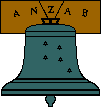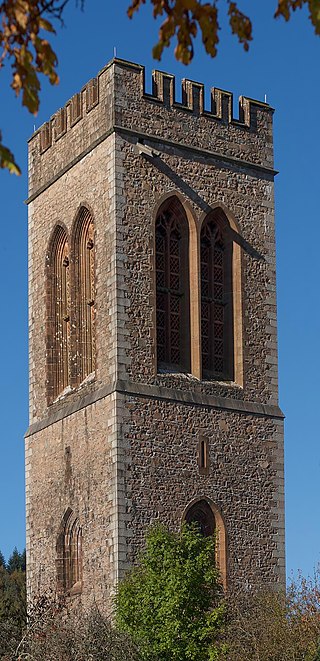

A peal board records on a wooden, metal, stone or canvas plaque a peal rung on church bells.


A peal board records on a wooden, metal, stone or canvas plaque a peal rung on church bells.
In modern terms a peal is the ringing of 5000 or more different changes on bells (5040 on 7 or fewer bells) in the "English style" of change ringing. The Central Council of Church Bell Ringers determines the rules for allowing a peal. [1]
Early peal boards often record a historical first achievement such as first peal on the bells (such as the first in the city of Chester) [2] or the first peal of a particular method. More commonly they record an event such as a royal occasion, induction of an incumbent or funeral of a ringer.
Many important peal boards were destroyed by incendiary bombs during World War II including that recording the first peal by the College Youths in 1725 at St Brides. [3]

Change ringing is the art of ringing a set of tuned bells in a tightly controlled manner to produce precise variations in their successive striking sequences, known as "changes". This can be by method ringing in which the ringers commit to memory the rules for generating each change, or by call changes, where the ringers are instructed how to generate each change by instructions from a conductor. This creates a form of bell music which cannot be discerned as a conventional melody, but is a series of mathematical sequences.
Campanology is the scientific and musical study of bells. It encompasses the technology of bells – how they are founded, tuned and rung – as well as the history, methods, and traditions of bellringing as an art.
Method ringing is a form of change ringing in which the ringers commit to memory the rules for generating each change of sequence, and pairs of bells are affected. This creates a form of bell music which is continually changing, but which cannot be discerned as a conventional melody. It is a way of sounding continually changing mathematical permutations.
The Oxford University Society of Change Ringers, founded in 1872, is the official society dedicated to change ringing in Oxford University. Its objects are to promote the art of change ringing in the university and to ring for Sunday services in Oxford during full term.

A "ring of bells" is the name bell ringers give to a set of bells hung for English full circle ringing. The term "peal of bells" is often used, though peal also refers to a change ringing performance of more than about 5,000 changes.

Dove's Guide for Church Bell Ringers is the standard reference to the rings of bells hung for English-style full circle ringing. The vast majority of these "towers" are in England and Wales but the guide includes towers from the rest of the British Isles as well as a few from around the world. The latest edition is Dove's Guide for Church Bell Ringers to the Rings of Bells of the World.

The Nottingham University Society of Change Ringers (NUSCR) is one of the oldest societies affiliated to the University of Nottingham Students' Union, being founded in 1958. Its principal aim is to allow students from both the University of Nottingham and Nottingham Trent University to practise English Change Ringing. It also represents the University at the annual Northern Universities Association (NUA) Striking Competition each November.
The Ancient Society of College Youths (ASCY) is a change ringing society, founded in 1637 and based in the City of London. The society played a leading role in the early development of change ringing, and today, it provides ringers for important events at St Paul's Cathedral and Westminster Abbey. Although it is a non-territorial association, its importance is recognised through having four representatives on the Central Council of Church Bell Ringers.

In campanology, a peal is the special name given to a specific type of performance of change ringing which meets certain exacting conditions for duration, complexity and quality.
Call change ringing is a branch of the art of change ringing, in which a group of English-style full-circle bell ringers are instructed continually to create different sequences, or changes, of the bells' striking order. Each command from the leader or "conductor" of the ringing results in a new sequence of sounding the bells. Each sequence is repeated until the next command or "call".

The Church of St Peter and St Paul is the Church of England parish church for the village of South Petherton, Somerset, England. The present church is a large and imposing cruciform-shaped structure constructed on the site of an earlier Saxon Minster, with the majority of the building dating from the 13th to 15th centuries; consequently, the building is Grade I listed.

The Central Council of Church Bell Ringers (CCCBR) is an organisation founded in 1891 which represents ringers of church bells in the English style.

Addleshaw Tower is the free-standing bell tower of Chester Cathedral, in Chester, Cheshire, England. It was designed by George Pace, and built to house the cathedral bells. These had been hung in the cathedral's central tower, and needed overhaul, but it was considered to be unsafe to re-hang them in the tower without disturbing its architectural features. Despite the design resulting in some local controversy, the tower is recorded in the National Heritage List for England as a designated Grade II listed building. It is the first free-standing bell tower to be built by an English cathedral since the 15th century.

The Australian and New Zealand Association of Bellringers, known as ANZAB, is the organisation responsible for the promotion of English-style "full circle ringing" – namely change ringing and method ringing in bell towers with a peal of bells – across Australia and New Zealand.
Albert John Pitman is regarded by change ringing campanologists as a remarkable and versatile composer of peals in bell ringing methods. Described as 'perhaps the greatest of all time' in the Central Council of Church Bell Ringers biography of him, An Unassuming Genius, he was an extraordinary talent in the field of peal composition.

The Suffolk Guild of Ringers for the Diocese of St Edmundsbury and Ipswich is a society and charity supporting the bell ringers and rings of bells in the Diocese of St Edmundsbury and Ipswich who practice the art of change ringing. The Guild was established on 2 April 1923 at Ipswich and covers over 200 rings of bells in the county of Suffolk in the area that falls within the diocese boundary.

The Duke's Tower, also known as Inveraray Bell Tower, is the detached bell tower of All Saints' Church, Inveraray, Argyll and Bute, Scotland. Standing 126 feet (38 m) high on the shores of Loch Fyne, it is a landmark for miles and amongst the most notable bell towers in the United Kingdom. The tower was built as a memorial to members of the Clan Campbell who died in the First World War. It is Grade A listed by Historic Environment Scotland, the highest possible rating.

The Norman Tower, also known as St James' Gate, is the detached bell tower of St Edmundsbury Cathedral, Bury St Edmunds, Suffolk. Originally constructed in the early 12th century, as the gatehouse of the vast Abbey of Bury St Edmunds, it is one of only two surviving structures of the Abbey, the other being Abbey Gate, located 150 metres to the north. The Abbey itself lies in ruins, approximately 200 metres to the east. As a virtually unaltered structure of the Romanesque age, the tower is both a Grade I listed building and a Scheduled Ancient Monument. The tower is considered amongst the finest Norman structures in East Anglia.
Campanology is the scientific and musical study of bells. It encompasses the technology of bells – how they are cast, tuned, and rung – as well as the history, methods, and traditions of bellringing as an art. Articles related to campanology include: